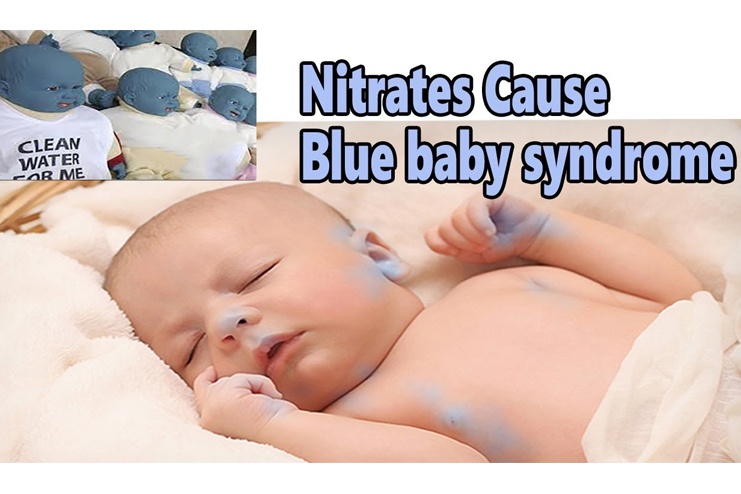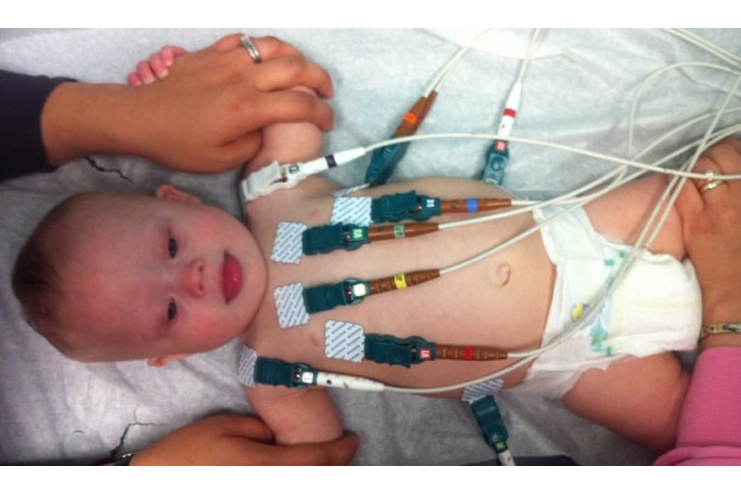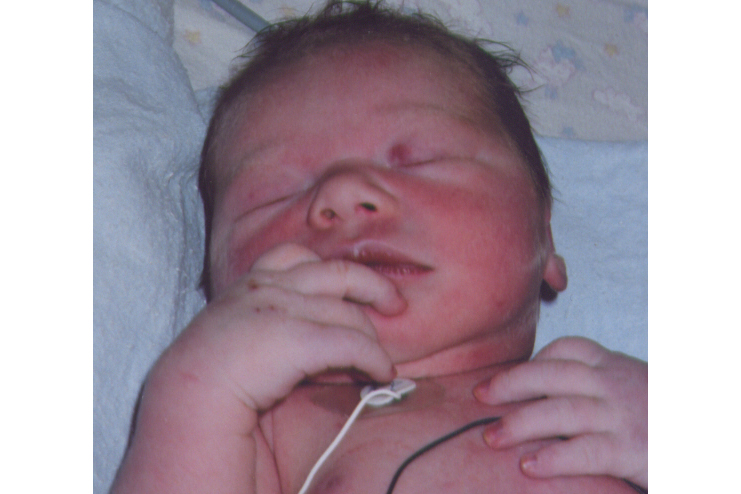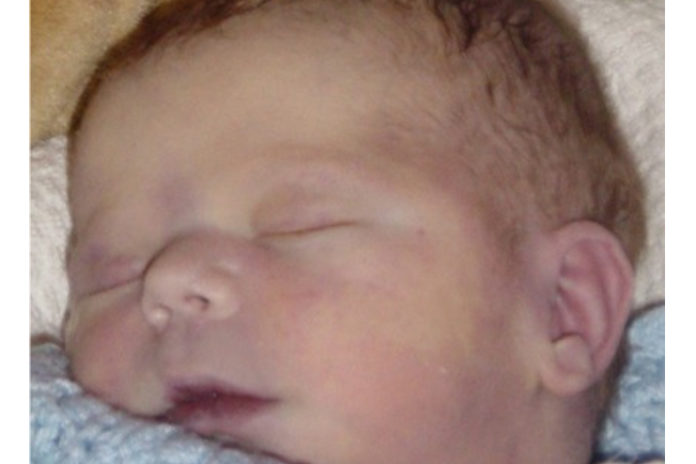Welcoming the newborn is one of the most joyful experiences of the parenting. The top most priority of the parents is to keep their baby safe and identifying the sickness of the baby is the typical task. The sick conditions like cold, and fever are common but there are some diseases that parents should be aware of for the immediate attention.
Blue baby syndrome is one of the illness in babies. The concept of this serious illness is the foreign object for many parents. Scroll down to get complete overview of blue baby syndrome.
What is Blue baby Syndrome?

It is a condition that affects the oxygen transportation of the blood and makes the skin to turn blue. The blue baby disease was discovered by American Cardiologist Hellen Brooke Taussig. This condition is characterized by the bluish or purple skin and is regarded as the cyanosis. This word is derived from the ‘Greek’ word which means ‘dark blue’. This blue tone is the result of lack of oxygen or the flow of de-oxygenated blood in the body. Due to congenital reasons you may have the blue baby at the birth.
This condition arises when the levels of oxygen in the blood are less than the normal due to the congenital heart defects. The most common defect is ventricular sepal defect (VSD), which is a condition where there exists a hole in the septum separating the two ventricles.
Generally, the deoxygenated blood from the body enters the right atrium from where it flows to the right ventricle. The blood from the right ventricle is transported to the lungs for the oxygenation.
The oxygenated blood from the lungs is transported to the left atrium and then to the left ventricle from where it is transported to all the parts of the body. In the case of VSD, deoxygenated blood flows to the right left ventricle through the septal hole for the supply to various body parts without getting oxygenated by the lungs. This deoxygenated blood causes the body to turn blue.
The bluish skin begins around at the age of 2-3 months. Initially, the bluish skin is recognized while the baby is cranky or passing the bowel. Later the baby appears blue all the time. The blue color is noticeable on the lips, earlobes, and nail beds. This condition requires immediate medical attention.
Causes of Blue Baby Syndrome:

Blue baby syndrome arises due to the environmental or congenital/genetic factors associated with the dysfunction of the heart, lungs, and blood pigment.
Here are a few causes of blue baby syndrome in babies:
1. Congenital Down Syndrome in Babies:
This is a genetic chromosome that causes developmental and intellectual delays. This condition results in the abnormal cell division and causes a distinct facial appearance, intellectual disability, and developmental delays. This syndrome is associated with the thyroid or heart disease.
2. Type 2 Diabetes in The Mother:
If the high sugar levels in the pregnant woman are not treated properly, then it may affect the infant after the birth. The infants may experience lower sugar levels soon after the birth due to high insulin levels in the body.
The child may experience blue or patchy skin, rapid heart rate and rapid breathing.
3. Contaminated Water With Nitrates:
It is one of the most common causes of blue baby syndrome. This condition happens whenever the baby drinks formula milk that is made with nitrate rich water. Then the body converts nitrates into nitrites. These nitrites may cling to the hemoglobin in the body forming methemoglobin, that is unable to carry the oxygen.
The nitrates are more common in the drinking water of the farming communities that use well water. This contamination happens due to the use of fertilizers and manure.
The following are the few sources from where the babies get their nitrates:
• Contamination of infant formula milk with the ground water.
• Drinking water
• Exposure to chemicals containing nitrates
• Exposure to certain drugs including dapsone, chloroquine, nitrobenzene, and benzocaine
4. Tetralogy Of Fallout:
TOF is a serious congenital heart condition leading to the four structural abnormalities in the heart that may in turn lead to the lack of oxygen in the blood. This condition may make the baby to look blue, this usually occurs at the birth.
5. Cyanotic Heart Disease:
It includes any type of structural heart defects that causes the mixing of the oxygenated blood with the deoxygenated blood and the supply of the unpurified blood to the parts of the body making it to look blue.
Any medications, uncontrolled diabetes, and drug usage may lead to heart defects in the babies. Some genetic conditions such as down syndrome may also lead to this condition.
The following types of cyanotic heart diseases are likely to cause blue baby syndrome in babies:
a. Parent truncus arteriosus (PTA): Failure of the division of major blood vessels of the heart lead to this condition.
b. Misplacement of major vessels: this defect occurs when the position of the aorta and pulmonary artery are interchanged.
c. Tricuspid atresia: This defect occurs due to the deformation of the valve between the right chambers of the heart that results in the blood to flow in the backward direction.
d. Anomalous pulmonary venous connection: the pulmonary veins that function to carry the blood to the heart do not function properly.
There are some other reasons for the babies less than 6 months older and adults to get cyanosis.
6. Hereditary Methemoglobinemia:
It is clinically known as autosomal recessive congenital methemoglobinemia. It is run and may run in the families. This problem results from the genes that stimulates the production of enzymes called nicitinamide adenine dinucleotide (NADH). The deficiency of this enzyme may lead to the low levels of the oxygen in the blood.
Hereditary methemoglobinemia is divided into two types.
Type 1: It is characterized only by the cyanosis with the symptoms related to the oxygen deficiency. Such as weakness or shortness of breath.
Type 2: It leads to neurological dysfunctions such as brain damage, uncontrolled muscle tensing, involuntary limb movements, microcephaly, and developmental delays.
7. Breath Holding Spells:
This is a condition where the child initially stats to hold the breath and this condition progresses towards the cyanosis. This condition is quite harmless and recovers soon without the intervention.
8. Other Diseases:
There are few other conditions leading to the blue baby syndrome including Tricuspid Artesia, Persistent Truncus Arteriosus, hypo-plastic left heart syndrome, Dextro-transportation of the main arteries and total anomalous pulmonary venous connection.
Signs and Symptoms of Blue Baby Syndrome:

These are the symptoms that the baby encounters during the blue baby syndrome:
1. Bluish color of the skin around the mouth, hands, and feet. Cyanosis due to hypothermia results in the blue skin near hands, and feet and due to heart disease results in blue skin around mouth.
2. Babies with cyanotic heart disease will have the following symptoms:
• Shortness or rapid breathing
• Loss of consciousness
• Round shaped nail bed
• Poor growth
• Encounter breathing difficulty during feeding
• Sweating while feeding
• Gums and tongue may turn blue
• Heart sounds may beat abnormally
3. Methemoglobinemia results in the slate like gray or bluish appearance of the skin. Babies with this form may encounter the following symptoms:
• Loss of muscular strength
• Dizziness and drowsiness
• Shortness of the breath
• Diarrhea
• Lethargy
• Impaired reflexes
• Production of saliva increases
• Seizures
How To Diagnose Blue Baby Syndrome?

The best way to diagnose this disease is to get your baby through the medical tests that are prescribed by the doctor.
The diagnose will run by taking a thorough medical history and by asking the symptoms, feeding patterns, and the conditions at the home. Physical examination will be done looking at the discolored areas and listening to the heart and lungs.
The following tests are usually done to recognize blue baby syndrome:
1. Blood examination
2. Tests for the lungs. Two tests will be performed to know the functioning of the lungs:
a. Chest X-ray to look at the lungs and the heart.
b. Oxygen saturation
3. The following tests are done to check the functionality of the heart
a. Electrocardiogram to look at the heart and tell how well it is functioning.
b. Echocardiogram
c. Cardiac catherization to observe the blood vessels and the structures inside the heart.
4. Blood gas analysis
5. In case of nitrate poisoning, methylene test is performed.
6. If congenital disease is suspected, genetic testing is performed.
In addition to testing the baby, it is required to test the tap water for nitrate levels. Water which has the nitrate levels below 10 mg per liter are considered as the safe. If the water has the nitrate levels above 10mg per liter, it is not safe to offer the infant.
How To Treat Blue Baby Syndrome?

The treatment for the blue baby syndrome depends entirely on the diagnosis. As seen earlier there are a wide range of reasons for this disease so that the treatment may differ largely.
1. Medication and oxygen therapy for the heart defects:
Medicines help heart to work better and help in reducing the impact of heart defects. The baby is also administered with oxygen to improve the oxygen levels in the blood.
2. Heart surgery:
It is performed to rectify the defects in the heart. Depending on the severity of the heart defect baby may require the surgery immediately or at the later age.
The following surgeries are usually performed to the heart:
A. Surgery for TOF: it is open heart surgery called Blalock-Thomas-Taussing shunt. It is performed for the total correction of the heart. Surgery is required for this condition because of the following reasons:
A hole in the heart which has to be closed surgically.
Any obstructions in the blood flow to the lungs are to be corrected through surgery. The duration of the surgery is six to eight hours and is usually performed under the supervision of anaesthesia. The recovery period for this surgery is two weeks.
B. Surgery for Transportation of the great arteries (TGA): The theme of this surgical procedure is to correct the natural hole in the baby’s heart. This surgical intervention is also known as Balloon Atrial Septostomy. This surgical process is completed with another intervention in two to three weeks of the age and it is usually completed within the first month of the baby’s birth. It is regarded as the arterial switch operation which helps in restoring the normal blood circulation. These procedures improve the flow of oxygenated and deoxygenated blood.
3. Medication for methemoglobinemia:
Some medicines like methylene blue can help in reducing the effects of methemoglobinemia and promotes the oxygen carrying capacity of the blood.
Methemoglobinemia resulting from the genetic defects might not be curable and require life long management.
4. Nutrient supplementation:
Supplementation with vitamins including vitamin C or absorbic acid might help to reduce the effects of nitrate and nitrite.
5. Blood Transfusion:
If the methemoglobin levels in the blood are very high then the doctor suggests the transfusion of the oxygenated blood.
In case of breath holding spells, some vitamin supplementations and the behavioral management advices are given to the parents.
6. Reduce the food that is full of nitrates:
Avoid the foods that are rich in nitrates like broccoli, spinach, beetroots, and carrots. Limit these foods till your baby turns 7 years old. It is best to use them in the frozen state rather than fresh.
7. Control diabetes:
This is one of the best ways to control blue baby syndrome. If you have any antenatal diabetes that should be controlled properly. If diabetes during the pregnancy is not treated properly it adversely affects your baby.
8. Avoid nitrate contaminated water:
The best way to avoid the blue baby syndrome due to nitrate contamination is to avoid the source of nitrates. If the private water source is the only option, then you can buy bottled distilled water from the local grocery store.
Don’t prepare baby formula with well water or give the well water to the babies till the age of 12 months. Boiling water can not remove the nitrates in the water and nitrate content should not exceed 10 mg/L. You can get the information about the nitrate levels in the water from the local health department. Most of the children with blue baby syndrome can live normal lives with few health consequences.
How to Prevent Blue Baby Syndrome?

Here are a few ways to prevent blue baby syndrome in your baby:
• Avoid the use of water that is contaminated with nitrates
• Avoid alcohol, smoking, narcotics, and other OTC medications during the pregnancy. These substances might cause birth defects including heart defects which is one of the causes of blue baby syndrome.
• Prefer breastfeeding over formula feeding.
In conclusion, Blue baby syndrome can be cured and in some other cases, it requires long term management. Conditions like methemoglobinemia can cure on its own when the baby’s body is skilled at handling the nitrate and nitrite. Staying alert to the skin color and other symptoms will help to diagnose the blue baby syndrome at the earliest and provide timely treatment.







































